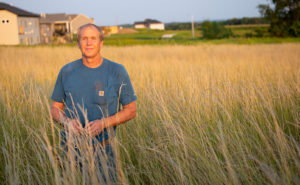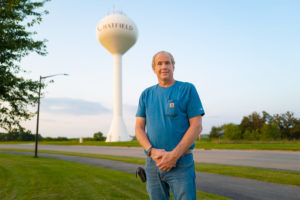Meet Paul Novotny, Continuous Living Cover farmer, steward & community leader

Article by Sylvia Bachmann, photos by Dodd Demas
Paul Novotny, 51, farms nears Chatfield, Minn., pursuing a career he hadn’t even considered until about 15 years ago. While his grandfather came from a farm, Paul’s family was in the trucking business, and he also kept busy as a City Council member.
But in 2006, an opportunity arose that created a confluence of his business experience, his agricultural roots, and, eventually, his interest in preserving the water quality in his community.
Here Paul shares some of the steps in his journey toward creating a more sustainable agricultural landscape for a 21st-century world, including participating in a pilot study with innovative Continuous Living Cover crops that prevent soil erosion and nitrogen run-off into local water supplies.
Q. How did you become a farmer?
A. About 15 years ago, I started farming our family’s 300 or so acres. I gradually expanded and am now farming about 1,800 acres of corn, soybeans and alfalfa, using low-tillage practices.
A. A few years ago, I learned about an innovative pilot program exploring the use of a continuous living cover crop called Kernza®. Continuous living cover crops are different from traditional commodity crops in that they are usually perennials, meaning they don’t have to be replanted every year. Because they stay in the field for a few years at a time, they help to slow erosion, improve soil health, enhance water availability and smother weeds. Also, growing a greater diversity of crops on a farm can reduce the risk of a total crop failure due to insects, diseases, or weather.
Q. What is Kernza, and how did the pilot program work?
A. Kernza is one of more than a dozen new perennial and winter annual cropping systems being developed by the University of Minnesota’s Forever Green Initiative. Kernza has a long, dense root system that can greatly reduce nitrate-nitrogen leaching and deliver other environmental benefits. It also is the first commercially-viable perennial grain in the U.S.
In the pilot program, I planted 25 acres of Kernza in the fall of 2017. (Winter crops, like Kernza, are planted in the fall and harvested the following summer, unlike corn and soybeans, which are planted in the spring and harvested in the fall.) Each year for three years, the program provided me with seed in year one, and financial and in-field technical support every year. Researchers also visited my field to monitor the crop, look for pest challenges, document weather conditions, test the soil and take a variety of other samples and measurements. At the end of each season, they purchased my crop and documented the total yield.
A. All crops need nitrogen to grow and produce good yields, and farmers have been applying nitrogen to fields in various forms since the 1850s. Without nitrogen fertilizers, we would lose up to one-third of the crops we rely on for human and animal food, fuels and other uses. Unfortunately, even when farmers calculate carefully and try to apply only as much nitrogen fertilizer as needed, sometimes there is excess nitrogen that does not get used by the plants and may run off into surface water (like streams and lakes) or leach through the soil to underground water supplies.
Across Minnesota and other agricultural states, nitrate levels in both surface and underground water supplies have been rising. This presents a danger to human health. Although nitrogen is a necessary nutrient for plants, high nitrate levels in people can harm the respiratory and reproductive system, kidney, spleen and thyroid in children and adults. It is particularly harmful to infants. To prevent human exposure to excess nitrates through drinking water, communities have had to develop expensive water treatment systems or drill new wells, which can cost a city $3-5 million dollars.
I farm in a drinking water supply management area (DWSMA), which means that some of my land surrounds a public water supply, and contamination of the surface or groundwater can affect the drinking water supply. As a farmer, resident, and member of Chatfield’s Public Works committee on water quality, I think it makes a lot more sense to prevent water contamination than to allow our water to become polluted and then to have to try to fix it.
A. Continuous Living Cover crops like Kernza help protect the environment — and our water supplies — in several ways. First, Kernza has a very deep root structure with roots that are twice as long as common annual wheat and thicker than the roots of corn and soybeans. These roots spread through the soil scavenging excess nitrogen that might otherwise move into ground- or surface water. In addition, because Kernza provides a continuous living ground cover for several years, it slows soil erosion. And when planted between rows of other crops, like corn and beans, cover crops provide great weed suppression, so less herbicides and/or tillage are needed to control weeds.
Q. Will we start seeing Kernza fields as we drive through rural Minnesota?
A. The plain truth is that farmers need to make a living, just like anyone else. Before farmers can consider planting some of their acres to cover crops, we need to have a market to sell the crop to. Kernza produces wonderful grain that can be made into flour for cooking and baking. Hopefully, these types of markets will grow, creating a demand for Kernza, making it economically feasible for farmers to rotate cover crops with other, traditionally more profitable crops like corn and soybeans. If we can get to that point, I think you will see more cover crops grown around the state.
Q. What are your plans for advancing the role of continuous living cover crops in Minnesota agriculture?
A. I and many others, including the U of M’s Forever Green Initiative and members of the Partnership, are working on developing commercial markets for Kernza and other cover crops, but that takes time. We’ve already learned that the stems, or stubble, from Kernza that remains in the field after harvest, makes great feed for dairy cattle due to its low potassium content; it’s great to have a market for that by-product, but we need to be able to sell the more valuable part of the plant, the grain, too. I’m excited that the market’s starting to grow, with Kernza being in demand for bakers and brewers, amongst others.
We also continue to look at the best and most economical ways to grow continuous living cover crops. While farming is always somewhat weather-dependent, minimizing labor and costly inputs will help make growing Kernza more profitable.
 My participation in the Kernza pilot study ended with the 2020 harvest, but those 10 acres are still in Kernza, and I planted another 28 acres of Kernza in fields that lie outside the DWSMA. I am particularly interested in seeing how it does on hillier, highly erodible land where I can’t plant corn and soybeans.
My participation in the Kernza pilot study ended with the 2020 harvest, but those 10 acres are still in Kernza, and I planted another 28 acres of Kernza in fields that lie outside the DWSMA. I am particularly interested in seeing how it does on hillier, highly erodible land where I can’t plant corn and soybeans.
I have also joined another study to look at another cover crop called Winter Camelina. Camelina can is grown primarily for its oil content that can be used as a healthy alternative cooking oil, as well as renewable aviation fuel and biodiesel.
With the potential to protect our water, save our soil and support the healthy growth of other crops while filling a growing need for food and fuel, cover crops are really worth our investment now.
Thank you Paul for taking the time to share your thoughts with not only the Forever Green Partnership but the Fillmore County Journal!